#Metamorphosis insectorum Surinamensium
Explore tagged Tumblr posts
Note
Please don't skip my message 🍉🇵🇸 to our honorable people in the world My name is Abdul Rahman from Gaza.. I lost everything in life.. My wife was martyred and my child and I were injured by a missile that fell on us.. My life was completely destroyed and I was severely injured all over my body especially my legs.. The missile tore my wife apart while she was carrying our child.. I ask for your support to start my life anew and overcome the tragedy I am going through.. Please help me with any amount no matter how small to treat my injury and my child's injury and get out of the Gaza Strip and start a better life.. And spread my campaign and my story so that everyone can see it 🍉🍉🇵🇸🇵🇸
Vetted by 90-ghost
https://gofund.me/c810ba27
Images for reference:





Liked this poll? Consider reblogging and/or donating to Abdul's vetted campaign!
#free palestine#palestine#asks#art#artists#artists on tumblr#all eyes on palestine#undescribed#4146/35000 as of today#polls#art history#Twittering Machine#Paul Klee#The Woodcutter#Nzante Spee#Metamorphosis insectorum Surinamensium#Maria Sibylla Merian#With My Back to the World#Agnes Martin#Fish Spirits Riding on Kayaks#Ruth Annaqtuusi Tulurialik#best of luck
3 notes
·
View notes
Text
Happy #WorldChocolateDay 🍫!

Maria Sibylla Merian (Germany 1647 - Dutch Republic 1717)
Cocoa Tree with Southern Armyworm Moth, 1702-03
Watercolour & bodycolour w/ gum arabic over etched lines on vellum, 37.7 x 28.4 cm
Royal Collection Trust RCIN 921183
“A watercolour of a branch of a Cocoa Tree (Theobroma cacao) with the life cycle of the Southern Armyworm Moth (Spodoptera eridania). This is a version of plate 26 in Merian's Metamorphosis Insectorum Surinamensium. In the text accompanying the plate, Merian described how, the Cocoa Tree was grown in the shade of a large tree such as a Banana, to protect it from the heat.”
“This is one of a set of luxury versions of the plates from Merian's Metamorphosis Insectorum Surinamensium, published in Amsterdam in 1705.
To make these versions, Merian (probably assisted by her daughters) appears to have inked sections of each etched plate and run it through the press to create a partial print. While the ink of that print was still wet, she placed a sheet of vellum against it, transferring a reverse image onto the vellum. This 'counterproof' was then worked up and coloured by hand. The Royal Collection plates are partially printed and partially hand-drawn, the printing mainly being used for the insects. As Merian was only transferring selected areas of the printed image, she could vary the arrangements of the plates, with the positions of the butterflies and moths subtly altered to create unique compositions.”
#animals in art#european art#natural history art#scientific illustration#botany#entomology#life cycle#moth#Southern Armyworm Moth#Cocoa#World Chocolate Day#Maria Sibylla Merian#women artists#women in science#18th century art#Metamorphosis insectorum surinamensium#Dutch art#colonial art#Royal Collection Trust
5 notes
·
View notes
Text





Maria Sibylla Merian (German, 1647-1717): Five Plates, from Dissertatio de Generations et Metamorphosis Insectorum Surinamensium (1719) (via Bonhams)
#Maria Sibylla Merian#women artists#women painters#art#painting#seventeenth century#eighteenth century#early women painters#early women artists#scientific illustration#german painters
228 notes
·
View notes
Photo

🍍 Metamorphosis insectorum surinamensium. Amsterdam: Voor den auteur, als ook by G. Valck,[1705].
82 notes
·
View notes
Text
More than three centuries after she made a perilous transatlantic voyage to study butterflies, a rare copy of the hand-coloured masterwork by the great naturalist and artist Maria Sibylla Merian is returning to Amsterdam.
The Rijksmuseum, which holds more than half-a-million books on art and history, last week announced it had acquired a rare first-edition copy of Metamorphosis of the Insects of Suriname (Metamorphosis Insectorum Surinamensium), described as a high point of 18th-century book production when the Dutch Republic was “the bookshop of the world”.
More than half-a-metre tall and illustrated with 60 richly coloured plates, Metamorphosis revealed to a wider public the transformation of tropical insects from egg to adult.
Merian and her daughters produced about 200 copies from 1705, but today only an estimated 67 remain, and few with colour illustrations.
“It’s one of the most fascinating books in natural history that we know,” Alex Alsemgeest, curator of library collections at the Rijksmuseum, told the Observer. Also “quite exceptional”, he said, was that Merian took the entire book production process “into her own hands”, from the voyage to Suriname to the commercialisation of the work, which was sold to merchants and scientists across Europe.
With its beautiful, sometimes disturbing images, rendered with pinpoint precision, Metamorphosis is a work of art and scientific scholarship, from a time when there was no rigid division between disciplines. It is also part of the story of Dutch colonialism. Merian recorded the local names of plants and insects she studied. In contrast to other European naturalists, she credited local people with helping her discover the colony’s wildlife, although didn’t name individuals.
Finally, there is the fascinating life of Merian herself. As a 52-year-old divorcee, she embarked on a self-funded voyage to Suriname in 1699, driven by relentless curiosity about the lives of insects.
Born in Frankfurt, Merian learned to paint in her artist stepfather’s workshop, and became fascinated by silkworms, moths and butterflies. She married one of her stepfather’s apprentices and had two daughters. Ensconced in a comfortable life in Nuremberg, she bred and sketched caterpillars, publishing celebrated books about the plants and insects around her.
At this time, many people still believed that insects spontaneously generated in the dirt. While Merian was not the first to show the transformation from egg, through larva and pupa, to adult insect, “her artistic talents helped to bring this message to a wider audience” Alsemgeest said.
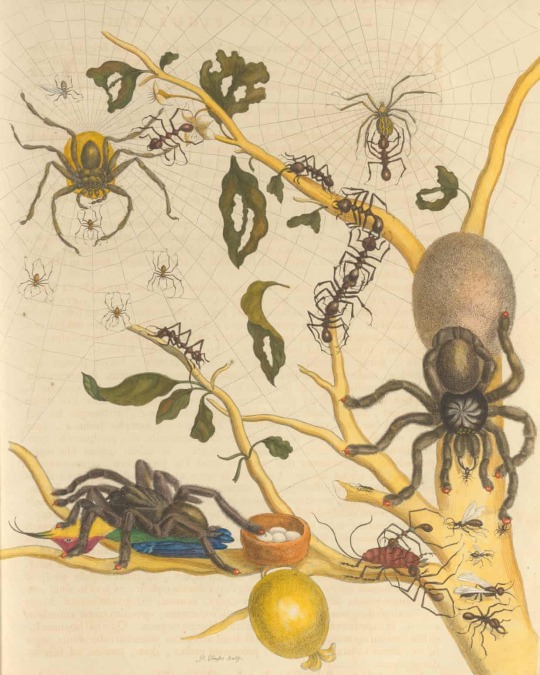
Described by the late historian Natalie Zemon Davis as “curious, wilful” and “a harder person to pin down” than other notable contemporaries, Merian left her husband to join a strict Protestant sect in Friesland, before eventually setting up a business in Amsterdam.
It was in the Dutch city she discovered in cabinets the vivid butterflies of Suriname, a Dutch colony until 1975, on the northern coast of South America. Having moved there with her younger daughter, Dorothea, she criticised Dutch settlers who only cared for sugar, ignoring the fertile potential of the soil for other crops.
While she wrote little about human behaviour, Merian noted the cruelty meted out to enslaved women. In a passage about a plant that induced abortions, she described them telling her that abortions would mean their children could be born free in their own country.
Her book depicted the beauty and savagery of the natural world, as well as some wincingly realistic creepy-crawlies. The first image shows cockroaches crawling over an unripened pineapple, a fruit then celebrated in Europe as a status symbol. In another illustration, a tarantula attacks a hummingbird. Merian is credited with giving the creature its Dutch name, vogelspin, meaning “bird-spider”.
Her image would be dismissed as a fantasy. Alsemgeest said: “In the 18th century, people responded: ‘that’s what you get when you send a woman to tropical places. She probably made that up’”. But scientists later confirmed her findings, he added.
The spider plate, he said, was a very good example of how Merian worked. “She was a really good observer.”
#radfem#radblr#radical feminism#gender critical#terfblr#radical feminist#radfem safe#terf safe#article#women in science#female artists
63 notes
·
View notes
Photo

Metamorphosis insectorum surinamensium - Maria Sibylla Merian - 1705 - via Internet Archive
748 notes
·
View notes
Photo
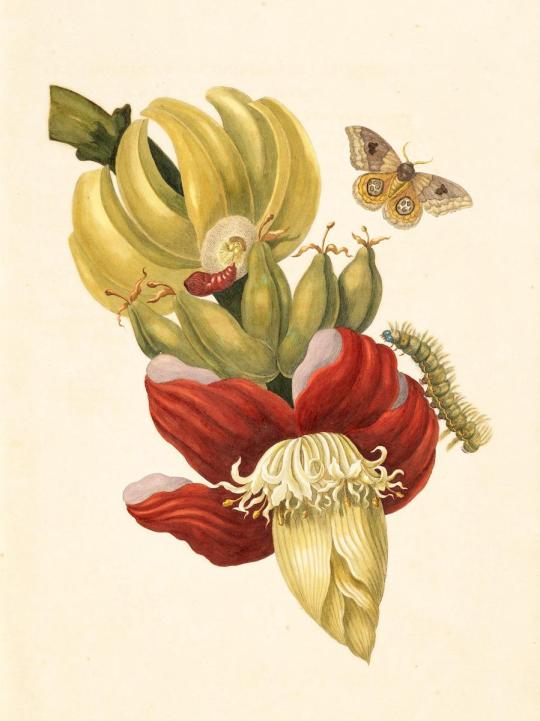
Banana Tree Flower with Io Moth, by Maria Sibylla Merian — who was born #onthisday in 1647.
From her pioneering Metamorphosis insectorum Surinamensium (Insects of Suriname), first published in 1705.
See more prints by her in our online prints shop: https://t.co/ASX37Nx31n
88 notes
·
View notes
Text
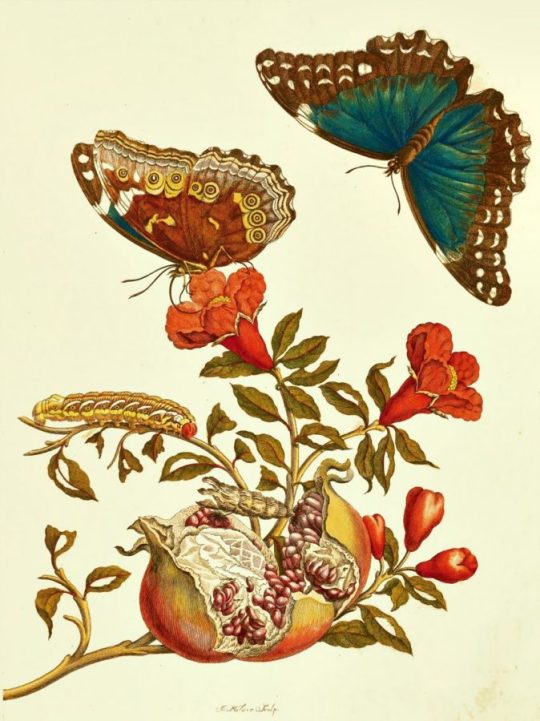
Maria Sibylla Merian (German, 1647-1717) • Pomegranate with Blue Morpho Butterflies and Banded Sphinx Moth Caterpillar • Illuminated Copper engraving from Metamorphosis insectorum Surinamensium, Plate IX by Maria Sibylla Merian • 1705
German entomologist, naturalist and scientific illustrator. She was one of the earliest European naturalists to document observations about insects directly. – Wikipedia
#art#painting#still life#fine art#art history#scientific drawing#maria sibylla merian#woman scientist#golden age entomologist#17th century naturalist#woman artist#german artist#drawing#naturalist#art of the still life blog#copper engraving#colored engraving#engraving#entomologic illustration
80 notes
·
View notes
Text

Pomegranate and Blue Morpho butterly. From the Book Metamorphosis insectorum Surinamensium, Maria Sibylla Merian, 1705.
#maria sibylla merian#pomegranate#blue morpho#vintage science illustration#vintage science art#antique illustration#vintage illustration#insects#entomology#horticulture#butterfly#caterpillar#pomegranates#uploads
20 notes
·
View notes
Text







Thysania agrippina is a species of moth in the family Erebidae. It was described by Maria Sibylla Merian in her 1705 publication Metamorphosis insectorum Surinamensium, and Pieter Cramer provided the formal description of the species in 1776. The most commonly accepted English name is the white witch. Other common names include the ghost moth, great gray witch and great owlet moth. Thysania agrippina is of interest as a competitor for title of "largest insect". This may be true by the measure of wingspan—a Brazilian specimen with a wingspan of almost 30 cm (12 in) appears to hold the record. The Atlas moth and Hercules moth, however, have greater wing areas. The white witch occurs from Uruguay to Mexico, and appears as a stray as far north as Texas in the U.S.[2] Collection dates shows no discernible pattern with respect to location or season.
One story of the derivation of the common name: early naturalists collected specimens of birds and bats with shotguns. An enormous darting flyer high in the canopy was a tempting target. Firing a cloud of pellets at a white witch moth did not necessarily bring it down, however, because the body is small relative to the wing area. The moth would sail along, an unkillable witch. This moth is of historical interest as the subject of a well-known painting by the artist Maria Sibylla Merian. Merian was an insightful naturalist who advanced the 18th-century understanding of insect life cycles; however, her depiction of the white witch life cycle does not match the actual biology of this species, as it depicts the larva of an unrelated moth.
Given the enormous geographic range of the adult, and observations that date back 300 years, it is striking that the immature life stages of this species have never been documented (notwithstanding the erroneous Merian painting). Long migratory flight is likely, given that the close relatives Thysania zenobia (the owl moth) and Ascalapha odorata (the black witch) are known for flights that reach far north of the host plant distributions. Based on the larval host plants recorded for the owl moth and black witch, the larval host plants for the white witch are probably also woody members of Fabaceae (subfamily Caesalpinioideae), possibly Senna or Cassia.
17 notes
·
View notes
Text

Maria Sibylla Merian (German, 1647-1717 ) • Metamorphosis insectorum Surinamensium • 1705 • Mediumhand-colored copper engraving print
#illustration#engraving#copper engraving#biological illustration#early 18th century scientific illustration#maria sybylla merien#illustrator#woman scientist#sassafras & moonshine blog#illustration blog
9 notes
·
View notes
Text
In a moving passage in her magnificent 1705 Metamorphosis insectorum Surinamensium, naturalist Maria Sibylla Merian (1647–1717) recorded how the Indian and African slave populations in Surinam, then a Dutch colony, used the seeds of a plant she identified as the flos pavonis, literally “peacock flower”, as an abortifacient: “The Indians, who are not treated well by their Dutch masters, use the seeds [of this plant] to abort their children, so that they will not become slaves like themselves. The black slaves from Guinea and Angola have demanded to be well treated, threatening to refuse to have children. …They told me this themselves.”
Londa Schiebinger in The Lancet. Exotic abortifacients and lost knowledge
I came to read this article becasue danah boyd introduced me to agnotology, a field of study I had not heard of before. Londa Schiebinger is an important scholar. Here is a list of her books and edited volumes.
11 notes
·
View notes
Text
Maria Sibylla Merian was born #OTD (German, 2 Apr 1647 – 13 Jan 1717).
Here are a few of her works that were recently on display at the “Making Her Mark: A History of Women Art in Europe, 1400-1800” exhibition at Baltimore Museum of Art :
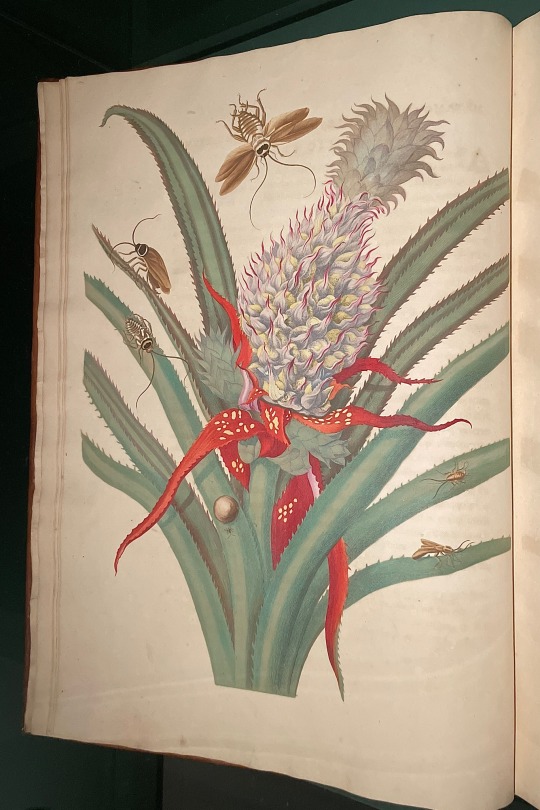

1. “Pineapple with Cockroaches” in Dissertatio de Generatione et Metamorphosibus Insectorum Surinamensium... (Dissertation on the generations and metamorphosis of Surinamese insects), 1719
Bound volume of hand-colored engravings and etchings
“This ripening pineapple's sweet aroma attracts a swarm of cockroaches. Maria Sibylla Merian observed this interaction during a three-year, self-financed voyage with her daughter Dorothea Maria to the South American country of Suriname, then a Dutch colony, in 1699. While there, Merian studied the native plant and insect life, learning their uses and behavior from enslaved African and Indigenous guides working at the sugar plantation where she stayed. In her notes, Merian characterized the pineapple as "the most outstanding of all edible fruits" and cockroaches as "the most infamous of all insects in America."
Merian's illustrations innovatively presented insect life cycles, habitats, and the broader ecological dynamic. After returning to the Netherlands, Merian published an illustrated compilation, creating one of the most important natural history publications of the time.
Her daughters Dorothea Maria Graff and Johanna Helena Herolt-Graff continued to issue editions after Merian's death, such as this deluxe version, contributing to their mother's foundational reputation in entomology.”

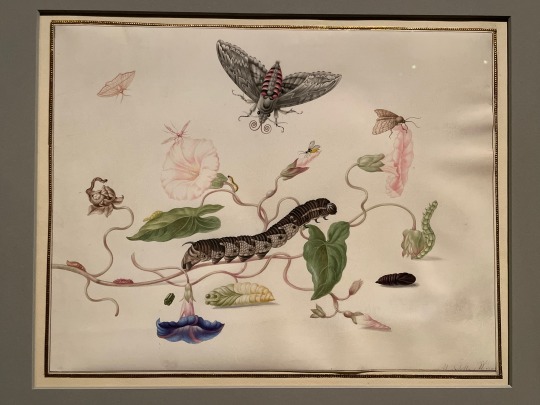
2. Frontispiece of Der Raupen wunderbare Verwandelung und sonderbare Blumen-Nahrung (The Wondrous Transformation of Caterpillars and their Curious Diet of Flowers), 1679-83
Bound volume w/ hand colored engraved illustrations
3. Convolvulus and Metamorphosis of the Convolvulus Hawk Moth, c.1670-1683
Watercolor w/ touches of opaque watercolor over indications in black chalk or graphite on vellum
“Maria Sibylla Merian had a close relationship with caterpillars, rearing them from egg to adult in her home over a decade. This engaging illustration of the life cycle of the convolvulus hawk moth on the wall above is the result of her sustained observations and her exceptional artistic talent. Creating an intertwined vignette of insect and plant life, Merian constructed a life cycle image that became a standard in scientific illustration and shaped the field of entomology. Her findings and illustrations contributed to a foundational reference text on insect metamorphosis, Der Raupen wunderbare Verwandlung und sonderbare Blumen-Nahrung, on display here.”
#animals in art#european art#museum visit#exhibition#Baltimore Museum of Art#Maria Sibylla Merian#women artists#women in science#women in STEM#book plate#frontispiece#watercolor#scientific illustration#natural history art#entomology#botany#caterpillars#butterflies#moths#lepidoptera#17th century art#metamorphosis#colonial art
13 notes
·
View notes
Text

Maria Sibylla Merian, "Lemon (2)." From Metamorphosis insectorum Surinamensium (2nd edition). 1705.
17 notes
·
View notes
Photo

🐛 Metamorphosis insectorum surinamensium. Amsterdam: Voor den auteur, als ook by G. Valck,[1705].
109 notes
·
View notes
Text

Maria Sibylla Merian
Metamorphosis insectorum Surinamensium
1705
#maria sibylla merian#entymology#botanical illustration#plants#insects#metamorphosis#butterfly#science and nature#wildlife#18th century art#tumblr art#tumblrstyle#artists on tumblr#tumblrpictures#women illustrators#women artists#art history#aesthetictumblr#tumblraesthetic#aesthetic
15 notes
·
View notes